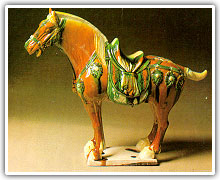| Tangsancai refers to the tri-coloured glazed pottery of the Tang Dynasty (618-907 A.D.), a painted earthenware which appeared in the wake of celadon. It is called "tri-coloured" be- cause yellow, green and white were normally used, although some pieces are also in two or four colours. Developed on the basis of the green and brown glazed-pottery of the Han Dynasty, it represented a peak in the development of Chinese ceramics and was already well-known in the world in its time. Unearthed tri-coloured Tangs are usually horses, camels, female figurines, dragon-head mugs, figurines of musicians and acrobats, and pillows. Of these, the three-coloured camels have won the greatest admiration. They are presented as bearing loads of silk or carrying musicians on their backs, their heads raised as if neighing; the red-bearded, blue-eyed drivers, clad in tunics of tight sleeves and hats with upturned brims, reproduce true to-life images of men from Central Asia of that time as they trudged along the Silk Road to the tinkle of camel bells. The tri-coloured glazed pottery of the Tang Dynasty was developed some 1,300 years ago by drawing on the skills of Chinese painting and |  |  sculpture and employing on the bodies the techniques of clay-strip forming and incising. The lines thus produced were rugged and powerful. Then glazes of different colours were painted on and, while chemical reactions took place in the process of firing in the kiln, they dripped naturally so that the colours mingled with each other and formed smooth tones. sculpture and employing on the bodies the techniques of clay-strip forming and incising. The lines thus produced were rugged and powerful. Then glazes of different colours were painted on and, while chemical reactions took place in the process of firing in the kiln, they dripped naturally so that the colours mingled with each other and formed smooth tones.
The tri-coloured Tang flourished during a rather short period of time (the 8th century) of the dynasty, when pottery pieces of this category were used by the aristocrats as funerary objects. So the finds today are limited in number and are considered to be rare treasures, valued for their brilliant colour and life-like shapes. Imitations now produced in Luoyang, Xitan and other cities of China are well received as tourist souvenirs because of their close resemblance to the authentic works. |